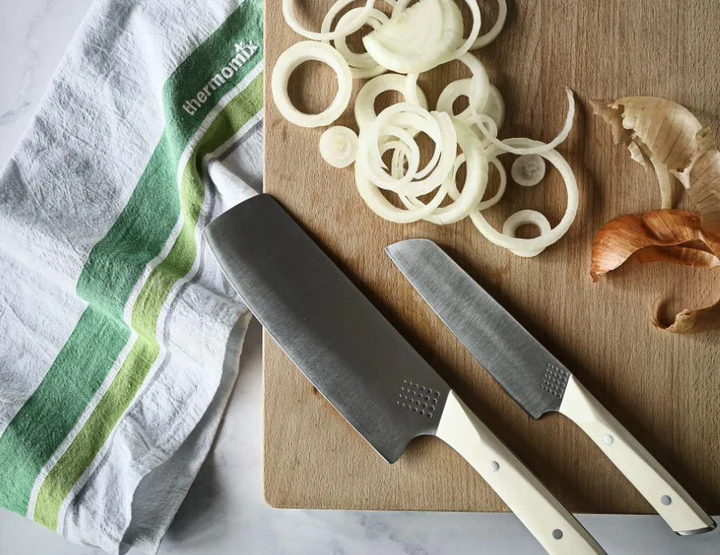Any cook needs a serrated knife. Its sharp teeth and unique design allow it to cut difficult meals with delicate innards. This article explores serrated knives’ features, usage, and benefits. If you’ve ever wondered what a serrated knife is and why it’s a kitchen essential, keep reading!
What Is a Serrated Knife?
Serrated kitchen knives have small, jagged teeth along the cutting edge. Serrated knives are called “saw-toothed” because their teeth resemble saws. Serrated knives are beneficial for various kitchen activities due to their blade serrations.
Serrations grab and cut tough-shelled, soft-meat meals. A serrated knife’s teeth bite into the food’s surface, making cutting simpler without crushing it. Bread, tomatoes, pastries, and citrus fruits have a hard crust or skin but a sensitive centre, thus this is helpful.
Serrated knives may execute jobs that straight-edged knives cannot. Serrated blades reduce food contact by creating pressure points. Minimising friction reduces food clinging to the blade. Serrated knives can cleanly cut through thick or slippery materials.
Serrated blades are used to slice bread because their teeth grasp the crust, making cutting easy without compressing the loaf. They are perfect for cutting soft fruits and vegetables like tomatoes and peaches, which a straight-edged knife can damage or squash.
Serrated knives may cut meat, especially roasts and tender cuts, as well as bread and fruit. The knife’s teeth slide into flesh without ripping or shredding.
Maintaining a serrated knife ensures its durability and functionality. Serrated blades are harder to sharpen than straight-edged knives, although specialised sharpening tools can help. Sharpening serrated knives requires following manufacturer directions or professional help.
Serrated knives are cleaned like other kitchen knives. Handwash the knife with mild soap and warm water to remove food particles from the serrations. Avoid tooth-damaging abrasives. Regular checks for damage and loose teeth may require professional service.
Serrated knives may cut difficult foods with sensitive innards. Its saw-like teeth cut bread, soft fruits, vegetables, and meats. Maintaining your serrated knife will keep it sharp and reliable for cooking.
The Anatomy of a Serrated Knife

Let’s examine a serrated knife’s anatomy to comprehend its use. Serrated knives typically have these parts:
Blade: Knife blades cut. Serrated knives have longer, thinner blades than chef’s knives.
Serrations: The blade’s teeth are tiny, pointed grooves. The knife’s use determines the serrations’ size, shape, and spacing.
Handle: The knife’s handle adds grip. Ergonomic and built of wood, plastic, or metal, it’s easy to use.
Bolster: The broad blade-to-handle connection is the bolster. It stabilises the knife.
Tang: The blade’s handle-extending tang. Full tangs, where the blade runs the length of the handle, are stronger.
The Versatility of Serrated Knives

Serrated knives are flexible and great for delicate cutting. Common uses for serrated knives:
Baking and Slicing Bread
Serrated knives slice bread best. Its strong teeth grasp the crust without squishing or breaking the loaf. A serrated knife cuts baguettes, artisan loaves, and cakes evenly.
Tomatoes, Soft Fruits
Cutting tomatoes, peaches, and other soft fruits without injuring the flesh is difficult. Serrated knives are great for cutting through skin and flesh. Cutting is stable because the teeth grasp the slippery surface.
Carving Meat
Serrated knives are great for slicing meat due to their sharp teeth. The serrations grasp the meat, ensuring smooth and precise slices. The saw-like movement cuts meat without ripping or shredding, creating lovely slices for your dishes.
Chop Hard Vegetables
Chef’s knives can struggle with butternut squash, pumpkins, and cabbage. A serrated knife’s saw-like edge makes it easier to cut these vegetables’ tough skins. The teeth grip the surface, making clean cuts easier and more controlled.
Cutting Citrus
A serrated knife transforms citrus fruit slicing. Oranges, lemons, and grapefruits are easier to slice because the knife teeth grab the rough skin. The serrations also prevent juice from leaking during slicing.
Cake Layers
Trimming cake layers for multi-tiered cakes or removing the domed top of a single-layer cake requires serrated knives. The saw-like edge ensures accurate and equal trimming for level, professional-looking cake layers for decorative designs and frosting.
Serrated knives are vital in professional and residential kitchens due to their versatility. Serrated knife FAQs:
FAQs
Sharpening serrated knives?
Serrated blades are harder to sharpen. Serrated knife sharpeners and sharpening rods with serrated parts help keep teeth sharp.
Sharpening serrated knives requires following manufacturer directions or professional help.
Cleaning and maintaining a serrated knife?
Serrated knives are cleaned like other kitchen knives. Handwash the knife with mild soap and warm water, removing food particles from the serrations. Avoid tooth-damaging abrasives. If required, get the knife serviced.
Serrated knives for bone-cutting?
Serrated blades are best for cutting difficult meals with soft interiors, not bones. Use a boning knife or cleaver to chop bones.
Serrated knives normally last how long?
The quality, frequency, and maintenance of a serrated knife determine its lifespan.
High-quality serrated knives can last years with proper care and sharpening. However, like any tool, the knife will lose usefulness and need to be replaced.v
Can a serrated knife be used for anything other than cooking?
Serrated knives can be used for more than cooking. Campers, hikers, and survivalists utilise serrated knives. They cut rope, fabric, and other materials, making them useful outdoors.
Conclusion
Finally, a serrated knife is a useful culinary utensil. Its strong blade teeth enable precise cutting of items with robust exteriors and sensitive interiors.
A serrated knife can cut bread, meat, hard veggies, and cake layers. Understanding serrated knife anatomy, applications, and maintenance will improve your cuisine and yield expert results.
Clean, sharpen, and store your serrated knife. Maintaining your serrated knife will extend its life.
